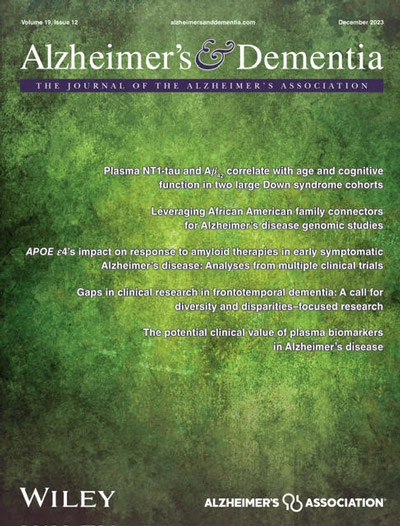Novel blood-based proteomic signatures across multiple neurodegenerative diseases
Abstract
INTRODUCTION
Blood-based biomarkers have the potential to support early and accurate diagnoses of neurodegenerative diseases, which are sensitive to molecular pathology and are predictive of outcome. We evaluated a novel multiplex proteomic method in people with diverse neurodegenerative diseases.
METHODS
Serum from people with Alzheimer's disease (N = 36), Lewy body dementia (N = 34), frontotemporal dementia (N = 36), and progressive supranuclear palsy (N = 36) and age-matched controls (N = 30) was analyzed with the nucleic acid linked immuno-sandwich assay (NULISA) central nervous system panel (≈ 120 analytes) and inflammation panel (250 analytes). Biomarkers were compared across groups and included as predictors of survival.
RESULTS
The NULISA panels demonstrated high sensitivity and reliability for detecting multiple biomarkers across neurodegenerative disorders. There were condition-specific proteomic biomarkers, while neurofilament light chain, corticotropin-releasing hormone, CD276, and a data-driven inflammation pattern were significant transdiagnostic outcome predictors.
DISCUSSION
The sensitive NULISA multiplex approach supports differential diagnosis and target identification, with prognostically informative dementia-related biomarkers.
Highlights
- We tested the novel technology nucleic acid linked immuno-sandwich assay (NULISA) in people with diverse neurodegenerative diseases, which demonstrated high sensitivity and reliability for detecting multiple biomarkers in serum samples.
- We compared the NULISA central nervous system serum results to single molecule array (Simoa) plasma assays for phosphorylated tau (p-tau)217, p-tau231, neurofilament light chain (NfL), and glial fibrillary acidic protein, finding strong correlations.
- Increased levels of serum NfL were identified across all patient groups and most elevated in the frontotemporal dementia (FTD) and progressive supranuclear palsy (PSP) cohorts, while p-tau epitopes were the most significant markers in patients with Alzheimer's disease (AD) and Lewy body dementia.
- Patients with FTD and PSP showed upregulation of many inflammation markers, compared to controls and patients with AD.
- We found condition-specific proteomic biomarkers, while NfL, corticotropin-releasing hormone, CD276, and data-driven immune signatures were significant transdiagnostic predictors of clinical outcomes (survival rates).


 求助内容:
求助内容: 应助结果提醒方式:
应助结果提醒方式:


